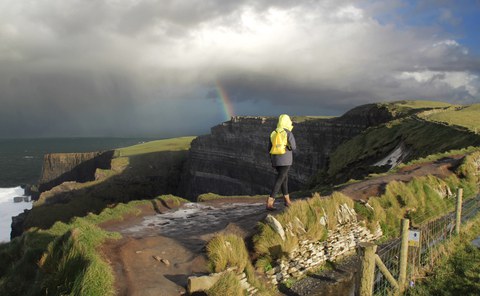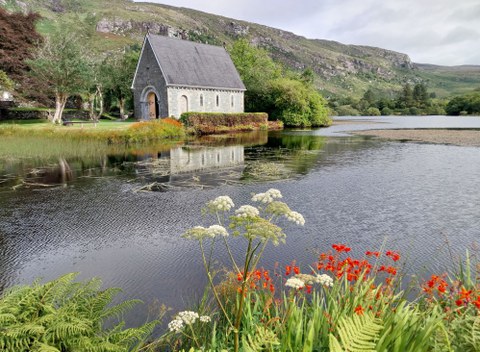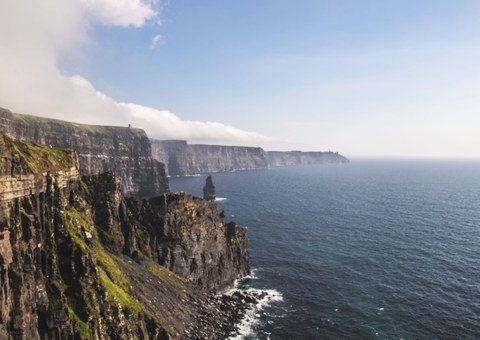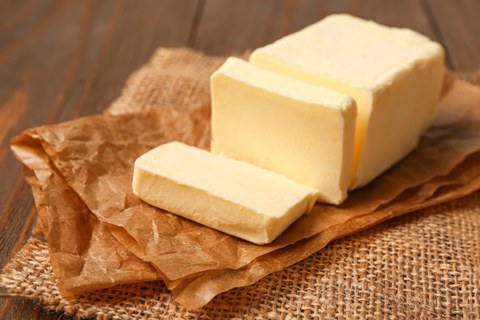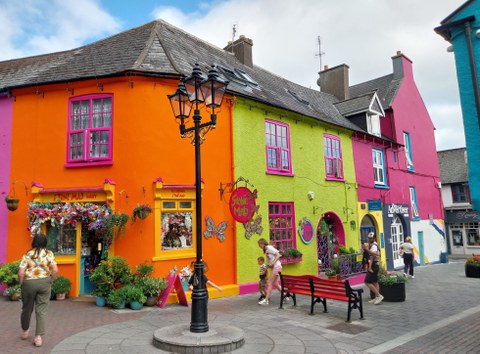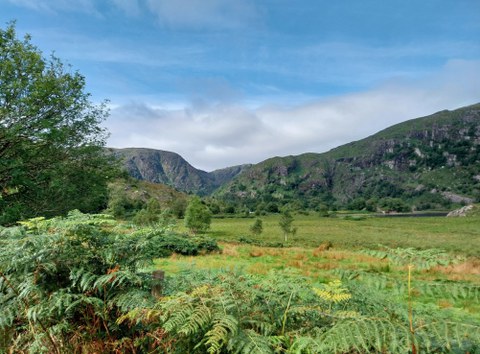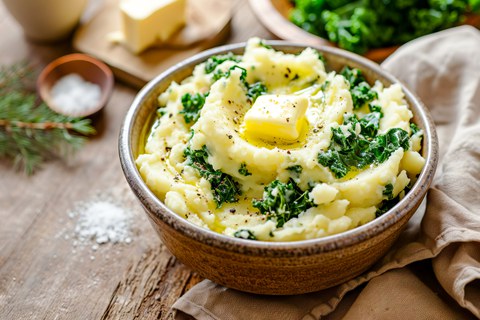Partner Country of the Month: Ireland
Ireland is the land of rainbows and grazing sheep, of rolling green hills, castles, and rugged coastlines. From Irish pubs and Guinness to traditional Irish folk music and mythology – the name of Ireland certainly catches the imagination. Luckily, we have exchange opportunities for you, so you can easily go and explore the Emerald Isle in real life as well. Read on to find out more about Ireland, its culture, and our Erasmus cooperations.
With the "Partner Country of the Month" campaign, we want to shine a spotlight on the wide diversity of countries, regions and partner universities of TU Dresden that our students can explore during a semester abroad.
Table of contents
General facts and figures about Ireland
Capital: Dublin
Population: 5.38 million (2024)
Official languages: English and Irish Gaelic
Coat of arms: A golden Celtic harp on a blue background
Currency: Euro
You can find further facts, figures and information on Wikipedia or Ireland.ie. For travel info, see Wikivoyage or Ireland.com.
Language matters
Ireland is a bilingual country. Irish Gaelic is the original language of Ireland – a Celtic language that is closely related to Welsh and Scottish Gaelic, among others. Today, after several centuries of English rule, only a few areas known as Gaeltacht use Irish as their daily language, while the majority of Irish people learn Irish as their second language at school. Here are a few phrases to impress your Irish friends:
- Hello – Dia duit [jeeya ditch] – Answer: Dia is Muire duit [jeeya is murah ditch]
- How are you? – Conas atá tú?
- I’m fine – Tá mé go maith [ta may go myh]
- Thank you – Go raibh maith agat [go row myh ug-it]
- Cheers – Sláinte [slawn-chuh]
- Welcome – Fáilte [fall-chuh]
In most regions and contexts, people in Ireland speak English. Of course, Irish English has its peculiarities, often stemming from Irish Gaelic. Why not listen to some Ireland travel tips to familiarize yourself with the accent? Don’t worry if you have trouble understanding things at first, Irish people are very friendly and helpful if you ask. And here is some typical Irish slang:
- craic – fun, as in That was great craic! and also What’s the craic? (What’s up?)
- grand – good or okay
- yoke – thingie
- a soft day – light rain, vs. it’s lashing / bucketing – heavy rain
- yer man / yer one – that guy / that girl (often just a stranger)
- away with the fairies – distracted or daydreaming
Please check the language proficiency requirements before applying to one of our partner universities. If needed, you can join the preparation course for a period abroad at TUDIAS to brush up your English.
Did you know that ....?
-
we have Ireland to thank for flavoured potato crisps? For a long time after the invention of potato crisps, only salt was added, until an Irish entrepreneur came up with cheese & onion flavouring in 1950. Other Irish innovations include the hypodermic needle for syringes, the binaural stethoscope, and even, in a way, modern chemistry (with the “first modern chemist” Robert Boyle).
-
Ireland was named for a goddess? According to legend, Ireland was once inhabited by the divine Tuatha Dé Danann. When the Celts invaded the land, they retreated to the Otherworld (also called Tír na nÓg), and the goddess Ériu agreed to give the Celts her blessing if the land was named for her. The name has since turned into Éire, and the ancients gods have become the faerie who inhabit old burial mounds and can bring good luck or misfortune. Even in modern times, the Irish often believe it’s better to be safe than sorry where the abodes of the fair folk are concerned.
- Ireland holds a number of records at the Eurovision Song Contest? Ireland and Sweden share the first place in the total number of Eurovision wins. Additionally, the Irishman Johnny Logan is the only person to date who has contributed three winning songs. He sang two of them himself and wrote a third.
- every August, a goat rules as a king in Ireland? The citizens of the southern Irish town of Killorglin capture a wild billy goat in the nearby mountains to star in Ireland’s oldest public festival, Puck Fair. He is crowned king by Queen Puck, a local primary school girl. King Puck then “rules” during the three-day festivities, before being dethroned and released back into the wild. Puck Fair dates back to at least 1613. But how did the goat receive his royal position? According to one legend, a wild goat warned the residents of Killorglin that English troops were near during the 17th century conquest of Ireland.
-
Ireland and the Native American Choctaw Nation see each other as kindred spirits? When Ireland passed through the worst year of the Great Famine in 1847, the Choctaw sent a generous donation, even though they had only recently been brutally driven from their lands. This solidarity between oppressed peoples marked the beginning of a long friendship that has led, among other things, to commemorative sculptures on both sides, a scholarship program for Choctaw in Ireland, and famine relief worldwide.
Cooperations with Universities in Ireland
You can find all cooperations of TU Dresden in our database. Have a look at the experiences of our previous exchange students at Questionnaires. Professors at your faculty may have direct contacts to your partner university of choice and can advise you.
Our cooperations with Irish universities are part of Erasmus+. You can find the contact persons and application deadlines for your faculty here.
Our cooperations in Ireland via Erasmus+
- University College Cork
- History of Art
- National University of Ireland Galway
- American and British Studies
- University of Limerick
- Psychology
Don't miss...
The Cliffs of Moher are quite rightly one of the most popular sights in Ireland. The steep cliffs stretch on for miles along the wild Atlantic west coast, rising up to 214 metres high. You can reach the visitor centre right next to the highest cliffs by bus, but maybe the most beautiful part of viewing the cliffs is a hike along the coastal path running towards the small town of Doolin. With a little luck, you will be able to see waterfalls, rainbows, and the Atlantic puffins that nest in the cliffs. Spending some time in the nearby Burren with its barren rocky landscapes and picturesque stone walls, wild goats, neolithic dolmen tombs and stone forts is also worthwhile.
The Butter Museum Cork. Ireland has many interesting museums, but our partner city Cork may have the most unique one, all about butter and the history of its production in Ireland. Surprisingly, there is a lot to discover – did you know that butter, a luxury food in medieval Ireland, was sometimes used as a payment method? Or that Irish peat bogs sometimes contain bog butter, conserved there for centuries? Today, butter still plays a large role as one of Ireland’s most important food exports.
Kinsale is a charming coastal town near Cork, known for its great restaurants, food festivals and cafés. The colourfully painted houses (especially in Market Street) also make a visit to Kinsale worthwhile. Historically, Kinsale was known for its fisheries and harbour, protected by the star-shaped Charles Fort. Today, Kinsale is the starting point of the Wild Atlantic Way, a famous road trip route that passes many stunning landmarks of Ireland's west coast.
The Book of Kells. Of course, you should not miss a visit to the capital of Ireland. In Dublin, the exhibition of Trinity College’s Old Library is particularly worth seeing. It contains the Book of Kells, a magnificently illuminated manuscript from the 9th century, decorated with intricate interlacing patterns and human and animal ornaments, carefully painted in expensive pigments. The Book of Kells is considered to be an outstanding example of medieval book illumination. The exhibition is very popular, so pre-book your visit.
Exploring Ireland's landscapes. Stunning landscapes are never far in Ireland, with beautiful spots close to each of our partner cities. Killarney National Park, not far from Cork and Limerick, offers lakes and mountains as well as the 19th century estate Muckross House and the ruins of Ross Castle. Near Galway, you can explore bogs and heaths at Connemara National Park, and see the picturesque Kylemore Abbey. For a longer trip, visit the Dingle Peninsula – here you will find mountains, rugged coastlines and sandy beaches side by side. If you take a ferry to the nearby Blasket Islands, you may even spot dolphins, whales, seals and sharks.
Let's get cooking...
Traditional Irish cuisine is full of hearty dishes that are perfect for a rainy, chilly day. Irish stew, prepared with potatoes, onions and mutton, is considered the national dish. Shepherd’s pie and cottage pie, casseroles of mashed potatoes, vegetables and minced meat, are popular as well. All three are typical pub food dishes. Of course, no evening in an Irish pub would be complete without a pint of Guinness. However, pubs (derived from ‘public house’) are not just places for getting a drink, but also for enjoying live music and socializing in general.
As you can guess, potatoes are an integral part of Irish cuisine. They are enjoyed in all kinds of shapes and forms – boiled, fried and mashed, but also prepared as boxty (potato pancakes) or potato farls (flatbread). Dairy products are also everywhere in Ireland – no wonder, given the high proportion of grazing land. Even the typical Irish soda bread contains buttermilk.
Recipe idea: Colcannon
This simple, hearty, and very comforting dish is a combination of two Irish staples, butter and potatoes. Starchy potatoes are mashed together with white cabbage or kale, and butter flakes are put into a hole on top, melting into the dish. Colcannon is often served at festivities like Saint Patrick’s Day or Halloween. It’s a very nostalgic dish for many Irish people, and there is even a folk song about it. You can find a recipe here.
Contact
Have you had a great time in Ireland? Do you have tips for places and experiences that are not to be missed? We would be happy to share your experiences here, on social media or, if you want, in information events for other TUD students. Get in touch with us:
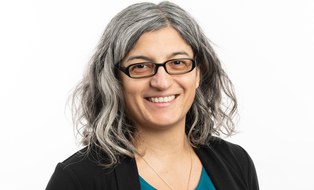 © Sven Ellger/TUD
© Sven Ellger/TUD
Advice on studying abroad
NameMs Federica Serra
Infocenter/ Study abroad; TUDworldwide: America
Send encrypted email via the SecureMail portal (for TUD external users only).
Visiting address:
Fritz Foerster Bau, Office 161 Mommsenstraße 6
01069 Dresden
Postal address:
TUD Dresden University of Technology International Office
01062 Dresden
Office hours:
- Tuesday:
- 09:30 - 11:30
- 12:30 - 14:30
- Thursday:
- 09:30 - 11:30
Please register at the SCS (FOE, floor 0).
Looking for first-hand information?
Would you like to know more about Ireland? Ask our alumni ambassadors - TUD alumni who are active in many countries around the world and can give you information and advice for your stay abroad.
Getting in touch is very easy: On this interactive world map, markers indicate the cities where our alumni ambassadors live. There is a short profile with contact information for each ambassador.
Partner Countries Archive
Have you missed a partner country? No worries! Here you can read up on all articles.
|
Europe (Erasmus+) |
|
|
Africa |
|
|
America |
|
|
Asia |
|
|
Australia and Oceania |
|

